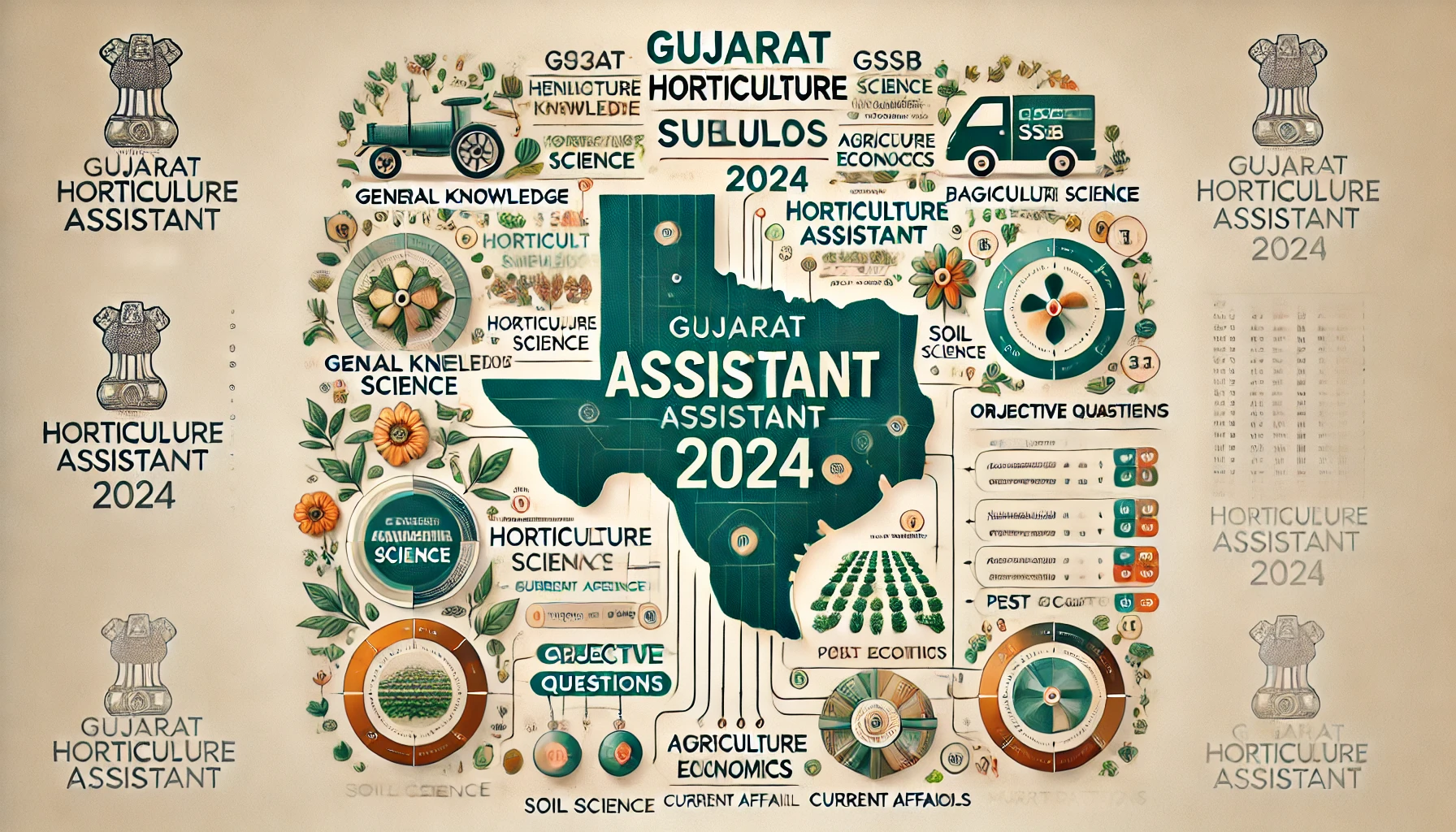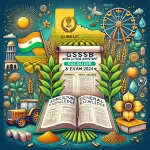Gujarat Subordinate Services Selection Board (GSSSB) will going to conduct online computer based examination for 52 posts of Horticulture Assistant (Bagayat Madadnish) to fill vacancies in the Gujarat state’s Office of Horticulture and Forestry and Gandhinagar Municipal Corporation.
Check Gujarat Horticulture Assistant Syllabus 2024 and GSSSB Bagayat Madadnish Exam Pattern to prepare for its online computer based test. All topics including subjects of technical knowledge are discussed here. Read the post carefully.
Contents
 GSSSB Horticulture Assistant Exam 2024
GSSSB Horticulture Assistant Exam 2024
The GSSSB Horticulture Assistant (Bagayat Madadnish) Exam assesses candidates on their knowledge of horticulture and other specific skills related to this field. Understanding the detailed syllabus and exam pattern is important for preparing early ands strategically.
| Recruitment Conducted By | Gujarat Subordinate Service Selection Board / Gujarat Gaun Seva Pasandgi Mandal (GSSSB) |
| Name of Exam | Horticulture Assistant [Bagayat Madadnish” (બાગાયત મદદનીશ)] Exam 2024 |
| No of Vacancies | 38 (Office of Horticulture and Forestry, Gandhinagar)14 (Gandhinagar Municipal Corporation) |
| Category | Syllabus Pattern |
| Notification Number | ૨૩૪/ ૨૦૨૪૨૫ (234/2024-25) |
| Selection Process | CBT Online Exam |
| Official Website | https://gsssb.gujarat.gov.in |
GSSSB Horticulture Assistant Exam Pattern 2024
The written examination is the most important part of the selection process. The paper will consist of multiple-choice questions (MCQs) covering various topics. Horticulture assistant exam pattern gives a structured overview of how the questions will be divided across different sections and the marks allotted for each part.
The written exam consists of a single paper divided in 2 parts with all multiple-choice questions (MCQs). The major sections include:
- Reasoning Ability and Data Interpretation
- Mathematical Ability
- Constitution of India, Current Affairs, Gujarati and English Comprehension
- Subject Related to Horticulture Assistant
| Subject | Number of Questions | Marks |
|---|---|---|
| Reasoning Ability and Data Interpretation | 30 | 30 |
| Mathematical Ability | 30 | 30 |
| TOTAL (PART-A) | 60 | 60 |
| Constitution of India, Current Affairs, Gujarati and English Comprehension | 30 | 30 |
| Subject Related to Horticulture Assistant | 120 | 120 |
| TOTAL (PART-B) | 150 | 150 |
| Total | 100 Questions | 100 Marks |
- Time Allotted: 3 hours (180 minutes).
- This will be Online Computer Based Recruitment Test (CBRT).
- The exam is objective in nature, and each correct answer carries 1 mark.
- There will be negative marking for wrong answers (1/4 or 0.25 marks deduction for each incorrect response).
- Minimum 40% marks are required to qualify Part-A and Part-B, individually.
GSSSB Horticulture Assistant Syllabus 2024
Reasoning and Data Interpretation (30 Questions, 30 Marks):- This section evaluates logical thinking, pattern recognition, and problem-solving abilities.
- Problems on Ages
- Venn Diagram
- Visual reasoning
- Blood relation
- Arithmetic reasoning
- Data interpretation (charts, graphs, tables)
- Data sufficiency
Mathematical/ Numerical Ability (30 Questions, 30 Marks):- To assess candidate’s knowledge of numerical ability. The topics includes:-
- Number Systems
- Simplification and Algebra
- Arithmetic and Geometric Progression
- Average
- Percentage
- Profit-Loss
- Ratio and Proportion
- Partnership
- Time and Work
- Time, Speed and Distance
- Work, Wages and chain rule
Constitution of India (10 Questions, 10 Marks):-
- Preamble of the Constitution
- Fundamental rights
- Directive principles of state policy
- Fundamental Duty
- Power, role and responsibility of President, vice president and governor
- Parliamentary system
- Amendment of Indian constitution, emergency provisions in Indian constitution
- Centre – State Government and their relation
- Judicial System of Indian Constitution
- Constitutional body
Current Affairs (10 Questions, 10 Marks):- Current events of state, national and international importance
Comprehension (Gujarati {5 marks} & English {5 marks}) (10 Questions, 10 Marks):- To assess comprehension, interpretation and inference skills in both Gujarati and English. A paragraph given with set of question on the basis of paragraph Or statement and assertion type question can be asked.
Questions and its Applications related to Technical Qualification of Horticulture Assistant (Bagayat Madadnish) (120 Questions, 120 Marks):-
- Definition, Importance and scope of Horticulture. Classification of fruit crops. Climate zones of Horticulture crops. Selection of site and soil. Soil and water testing for orchards.
- Scope of vegetable cultivation in India and Gujarat State. Importance of vegetables in human nutrition and their role in diversification. Role of soil, climatic and agronomic factors in vegetable and floriculture production. Principles of cultivation including direct sowing, nursery management, transplanting, hardening of seedlings and vegetable forcing. Weeds and their control. Rotation and Inter cropping in vegetable crops.
- Introduction to floriculture and landscaping. Planning of gardens. Formal and informal gardens. Use of trees, shrubs, climbers, palms, houseplants and seasonal flowers in the gardens. Making and maintenance of lawns. Training and pruning of rose, pinching disbudding in chrysanthemum etc. Landscaping-art principles.
- Planning and layout of orchards – different types of layout systems, planting distance in different fruit plants, high density plantation. Digging and filling of pits. Media for nursery production. Raising of virus free fruit plants. Role of growth regulators.
- Different types of irrigation systems (Drip, flood, sprinkler, check basin etc.). Nutrition management: chemical composition of different organic and inorganic fertilizers and their application. Fertilization, foliar application of nutrients and role of bio fertilizers in different Horticulture crops. Leaf sampling in different fruit crops. Nutritional deficiencies in horticultural crops.
- Weeds- Introduction, harmful and beneficial effects, characteristics and classification and their application. Type of mulches and their role in Horticulture. Green manuring, inter cropping in horticultural crops. Different types of sprayers and horticultural tools.
- Soil sterilization and fumigation; seed treatment: stratification, scarification, preparation of seed and nursery beds, raising of nursery for different horticulture crops, transplanting of seedlings, preparation of potting mixtures for propagation of plants. Potting and re potting. Frost protection measures in Horticultural crops.
- Sexual and asexual propagation their advantages and disadvantages. Different methods of propagation for Horticulture crops – cutting, layering, grafting, budding, tissue culture etc.
- Training and pruning and their importance, Canopy management of Horticultural crops. Rejuvenation techniques for old and senile orchards. Post-harvest management for horticultural crops (Harvesting techniques, maturity indices, storage and ripening techniques; grading and packaging).
- Major insect-pests and diseases in fruit crops Identification of insect-pests and diseases
and their control measures. - Cultivation of different major and minor fruit crops of Gujarat and India. (Introduction, origin and distribution, soil and climate requirement, improved cultivars, propagation, planting methods, irrigation and fertilizers, weed management, intercropping, harvesting and handling, storage, insect- pest/disease/disorders).
- Hybrid seed production of chilli, brinjal, tomato and muskmelon. seed plot technique, seed production in flowers.
- Cultivation of potato, brinjal, chilli, tomato, root crops, cucurbitaceous, leafy vegetables: climate, soil, varieties, sowing, seed rate, method of sowing, diseases and pests, harvesting and post-harvest handling.
- Cultivation of shrubs, tree, climbers, cut flowers, annual, pot flowers, rose, gladiolus, etc.
- Harvesting, grading, packaging and post harvest management in vegetables and flowers.
- Importance of organic production of vegetable crops; Methods for enhancing soil fertility, mulching, raising green manure crops. Indigenous methods of compost, Panchgavya, Biodynamics preparation etc. Certification or organic products; organic production and export opportunity and challenges.
Note: Please note that is not an official syllabus released on the GSSSB official website. Horticulture assistant syllabus provided here is just for study reference only so that candidates can start their exam preparations early. Once officially released, it will be updated here.
Important Links For Gujarat Horticulture Assistant Exam
- Must See: GSSSB Agriculture Assistant Syllabus & Exam Pattern 2024 (Kheti Madadnish)
- For Latest GSSSB Updates:- https://4syllabus.in/tag/gsssb
- For Latest Government Jobs in Gujarat:- https://4syllabus.in/tag/gujarat/
- Official GSSSB Website:- https://gsssb.gujarat.gov.in
- For Official GSSSB Horticulture Assistant Notification:- CLICK HERE
The GSSSB Horticulture Assistant (Bagayat Madadnish) Exam 2024 offers a promising career opportunity for candidates interested in Gujarat state’s horticulture and agriculture department.
By following the detailed syllabus and exam pattern, aspirants can plan their preparation effectively and maximize their chances of success. Stay focused, keep revising, and practice consistently to ace the exam. Best of Luck.
Important FAQS
What are the main subjects included in the Gujarat Horticulture Assistant syllabus?
The key topics include:
- Horticulture and its practices
- Crop production and management
- Soil Science and water conservation techniques
- Pest and disease management
- Basic knowledge of agriculture economics
- Government schemes related to agriculture and horticulture
Is there any negative marking in the exam?
yes, 1/4 marks will be deducted for negative marking.
What is the time duration for the exam?
3 hours (180 minutes)
Is knowledge of Gujarat-specific agriculture practices required?
Yes, since the exam is focused on Gujarat, knowledge of local agricultural practices, government schemes, and regional challenges in horticulture is beneficial.







